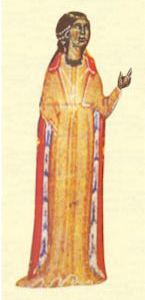 W
WThe trobairitz were Occitan female troubadours of the 12th and 13th centuries, active from around 1170 to approximately 1260. Trobairitz is both singular and plural.
 W
WIn the surviving historical record, Medieval Arabic female poets are few compared with the number of known male Arabic-language poets: there has been 'an almost total eclipse of women's poetic expression in the literary record as maintained in Arabic culture from the pre-Islamic era through the nineteenth century'. However, there is evidence that, compared with medieval Europe, women's poetry in the medieval Islamic world was 'unparalleled' in 'visibility and impact'. Accordingly, recent scholars emphasise that women's contribution to Arabic literature requires greater scholarly attention.
 W
WChristine de Pizan or Pisan, born Cristina da Pizzano, was a poet and author at the court of King Charles VI of France and several French dukes. Venetian by birth, Christine served as a court writer in medieval France after the death of her husband. Christine's patrons included dukes Louis I of Orleans, Philip the Bold, and John the Fearless. Her best known works include The Book of the City of Ladies and The Treasure of the City of Ladies, both written when she worked for John the Fearless of Burgundy. Her books of advice to princesses, princes, and knights remained in print until the 16th century.
 W
WThe Comtessa de Dia, possibly named Beatritz or Isoarda, was a trobairitz.
 W
WGarsenda was the Countess of Provence as the wife of Alfonso II from 1193 and the Countess of Forcalquier in her own right from 1209. She brought Forcalquier to the House of Barcelona and united it to Provence. She was also a patron of Occitan literature, especially the troubadours, and herself wrote some lyric poetry and is counted among the trobairitz as Garsenda de Proensa. She was, in the words of her most recent editors, "one of the most powerful women in Occitan history".
 W
WGwerful Fychan was a poet during the period of the Welsh Beirdd yr Uchelwyr during the late Middle Ages. She came from a noble family, her full name in genealogies being given as Gwerful ferch Ieuan Fychan ap Ieuan ap Hywel y Gadair ap Gruffudd ap Madog ap Rhirid Flaidd, and was the heiress of the mansion of Caer-Gai, near Llanuwchllyn, Merioneth. The name Fychan was later anglicised as Vaughan.
 W
WHadewijch was a 13th-century poet and mystic, probably living in the Duchy of Brabant. Most of her extant writings are in a Brabantian form of Middle Dutch. Her writings include visions, prose letters and poetry. Hadewijch was one of the most important direct influences on John of Ruysbroeck.
 W
WBorn in Gandersheim to Saxon nobles Hrotsvitha was a German secular canoness, who wrote dramas and poems during the rule of the Ottonian dynasty. Hrotsvitha lived at Gandersheim Abbey. She is considered the first female writer from the German Lands, the first female historian, the first person since antiquity to write dramas in the Latin West, and the first female poetess in Germany.
 W
WN'Iseut de Capio was a noblewoman and trobairitz from Gévaudan. She was a neighbour and contemporary of the trobairitz Almucs de Castelnau, with whom she shared the composition of a tenso. It is her only surviving piece of work.
 W
WTumāḍir bint ʿAmr ibn al-Ḥārith ibn al-Sharīd al-Sulamīyah, usually simply referred to as al-Khansāʾ was a 7th-century tribeswoman, living in the Arabian Peninsula. She was one of the most influential poets of the pre-Islamic and early Islamic periods.
 W
WMarie de France was a poet, possibly born in what is now France, who lived in England during the late 12th century. She lived and wrote at an unknown court, but she and her work were almost certainly known at the royal court of King Henry II of England. Virtually nothing is known of her life; both her given name and its geographical specification come from her manuscripts. However, one written description of her work and popularity from her own era still exists. She is considered by scholars to be the first woman known to write francophone verse.
 W
WSaionji Kishi , or more formally Fujiwara no Kishi , was an Empress consort of Japan. She was the consort of Emperor Go-Daigo of Japan. She was given the regnal name Reiseimon-in (礼成門院) in 1332 when her husband was banished, but it was abolished when he returned to the chrysanthemum throne in 1333. Later she was given the second regnal name Go-Kyōgoku-in (後京極院) upon her death. She was also an excellent poet, 14 of whose waka poetry are included in chokusen wakashū.